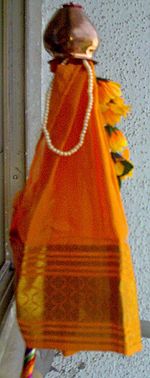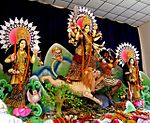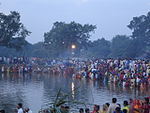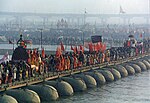હિંદુ ધર્મના ઉત્સવો
તહેવાર કે ઉત્સવ એ હિંદુ ધર્મ અને ભારતીય સંસ્કૃતિનું અભિન્ન અંગ છે. તહેવાર એ હિન્દી ભાષાના तेहवार કે त्योहार શબ્દનું ગુજરાતી છે. ફારસી ભાષામાં ’તિહ=ખાલી’ અને ’વાર=નામદર્શી પ્રત્યય’ મળીને ’તેહેવાર’ શબ્દ આવે છે જેનો અર્થ ’મુસલમાની દીનમાં ફરમાવેલો પાક દિવસ’ એવો થાય છે. ગુજરાતીમાં ’તહેવાર’નો અર્થ અણૂજો, અકતો. ઉત્સવ, ખુશાલીનો દિવસ, વારપરબ એવો થાય છે.[૧] મહદાંશે બહુમાન્ય જાહેર ઉત્સવને તહેવાર તરીકે ઓળખવામાં આવે છે.
હિંદુ ધર્મમાં લગભગ બધાં જ તહેવારો પંચાંગ પ્રમાણે, તિથી અનુસાર ઉજવવામાં આવે છે. મકર સંક્રાંતિ જેવા કોઈક તહેવાર સૂર્ય આધારીત ગ્રેગોરીયન પંચાંગની તારીખ આધારીત હોઈ શકે છે.
હિંદુ ધર્મના મુખ્ય/મહત્વનાં તહેવારોની યાદી
[ફેરફાર કરો]| મહત્વનાં તહેવારો | ચિત્ર | તિથી | વિગત |
|---|---|---|---|
| મકર સંક્રાંતિ કે પોંગલ |
 |
મકર સંક્રાંતિ અને પોંગલ સૂર્યનાં મકર રાશીમાં પ્રવેશ સમયે ઉજવાય છે. આ પછી ઉત્તરોત્તર દિવસો લાંબા થતા જાય છે. પોંગલ એ ઉતરાયણનો પ્રથમ દિવસ હોય છે અને આ દિવસે તમિલ માસ ’થાઈ’ની શરૂઆત થાય છે. |
દક્ષિણ ભારતમાં પોંગલ એ ખુબ જ પ્રસિદ્ધ એવા લણણી (તૈયાર થયેલા પાકની કાપણી) તહેવારો માં નો એક છે. જે દરવર્ષે મધ્ય જાન્યુઆરીમાં આવે છે અને એ ઉતરાયણની શરૂઆત ગણાય છે. પોંગલનો તહેવાર ચાર દિવસ સુધી ઉજવવામાં આવે છે. ઉજવણીમાં "પોંગલ" તરીકે ઓળખાતી સ્વાદિષ્ટ વાનગી રાંધવામાં આવે છે.[૨] આ દિવસ મકર સંક્રાંતિ સાથે એકરુપ હોય છે. |
| વસંતપંચમી |
 |
મહા સુદ પાંચમ | વસંતપંચમીને બંગાળ અને ઓરિસ્સામાં સરસ્વતી પૂજા તરીકે પણ ઓળખવામાં આવે છે. આ દિવસ સરસ્વતી દેવીની આરાધના, પૂજન અર્ચનનો ગણાય છે.[૩] |
| થાઇપુસમ કે કવડી (ઉચ્ચારભેદ સંભવ) |
 |
તમિલ માસ ’થાઇ’ની પૂર્ણિમા | થાઇપુસમ એ મોટાભાગે તમિલ સમાજ દ્વારા ઉજવાતો હિંદુ તહેવાર છે. થાઇપુસમ શબ્દ તમિલ માસ ’થાઇ’ અને ’પુસમ’ પરથી લેવામાં આવ્યો છે. તમિલ ભાષામાં તે તહેવાર સમયે ચંદ્રની નજીકનાં તારાને દર્શાવે છે. આ તહેવાર, દેવી પાર્વતીએ, સૂરપદ્મન નામના રાક્ષસ સામે લડવા માટે, દેવ મુરુગનને ભાલા નામનું શસ્ત્ર આપ્યું હતું તેની યાદગીરી રૂપે ઉજવવામાં આવે છે.
કવડી અટ્ટમ (તમિલ:காவடி ஆட்டம்) એ તમિલ લોકોના યુદ્ધદેવતા મુરુગનની સન્મુખ તેમના ભક્તો દ્વારા ઉપાસના સ્વરૂપે કરાતું નૃત્ય છે.[૪] |
| મહા શિવરાત્રિ |
 |
મહા વદ ચૌદશ | મહા શિવરાત્રિ એ હિંદુ ધર્મનો અને શિવભક્તોનો મહત્વનો તહેવાર છે.[૫] |
| હોળી |
 |
ફાગણ સુદ પૂનમ | હોળી કે ફાગવા એ ઘણો જાણીતો વસંતઋતુનો તહેવાર છે. હોળીનો તહેવાર પ્રહલાદનો બચાવ અને હોલીકાનાં દહનની ઉજવણીરૂપે મનાવાય છે. આ દિવસે ઠેરઠેર છાણાં-લાકડાંઓની હોળી ખડકી તેનું દહન કરાય છે. |
| રંગપંચમી |
ફાગણ વદ પાંચમ | ભારતમાં અનેક સ્થળે ઉજવાતા આ તહેવારને શ્રીપંચમી પણ કહે છે. | |
| Shigmo |
 |
Shigmo is celebrated in Goa as one of the prominent festivals of the Konkani Hindu community. | |
| Gangaur |
 |
"Gangaur" is the colourful and the one of the most important festivals of people of Rajasthan and is observed throughout the state with great fervour and devotion by womenfolk who worship Gauri, the consort of Lord Shiva during March–April. | |
| Vasant Navratri |
 |
Navratri is the Hindu festival of worship and dance. In Sanskrit the term literally means "nine nights". During this festival the forms of Shakti are worshipped, and effigies are burned. | |
| Rama Navami |
 |
Rama Navami is the celebration of the birth of Rama. Rama Navami is the day on which Lord Rama, the seventh incarnation of Lord Vishnu, incarnated in human form in the land of Ayodhya. He is the ardha ansh of Vishnu or has half the divinitive qualities of Lord Vishnu. The word “Rama” literally means one who is divinely blissful and who gives joy to others, and one in whom the sages rejoice. Ram Navami falls on the ninth day of the bright fortnight in the month of Chaitra (April/May) and coincides with Vasant Navratri or Chait Durga Puja. Therefore in some regions, the festival is spread over nine days. This day, marking the birthday of Lord Rama, is also observed as the marriage day of Rama and Sita and thus also referred to as Kalyanotsavam. In Ayodhya, the birthplace of Lord Rama, a huge fair is held with thousands of devotees gathering to celebrate this festival. The fair continues for two days, and rathyatras, carrying the Deities of Ram, his brother Laxman, His wife Sita, and His greatest devotee Mahavir Hanuman, are taken out from almost all Ram Temples. Hanuman is known for is his devotion to Rama, and his tales form an important part of the celebration. In Andhra Pradesh, Ram Navami is celebrated for 10 days from the Chaitra saptami to the Bahula Padyami that fall in the month of March and April. Temples re-enact the marriage of Lord Rama and Sita to commemorate this event, since this day is also the day they got married.[૬] | |
| Gudi Padwa, Chetichand |
 |
First Day of waxing moon of Chaitra (Hindu Calendar) | Gudi Padwa / ChetiChand is celebrated on the first day of the Chaitra month, and is celebrated as New Year's Day by Marathis, Konkanis and Sindhis . According to the Brahma Purana, this is the day on which Brahma created the world.The date keeps changing every year in the month of march. |
| Ugadi |
 |
Ugadi (meaning "the start of an era" in Kannada) is New Year's Day for the Kannadigas and Telugus. It takes place on the same day as Gudi Padwa. | |
| Mesha Sankranti |
 |
First day of solar month of Vaisakha. | Mesha Sankranti (also called Vaisakha Sankranti represents the transition of the sun into the Mesha (Aries) Zodiac. Marks the start of the solar new year in lunisolar calendars. Involves bathing in holy waters. Regional new year festivals are also observed on this day such as Vishu, Pohela Boishakh and Vaisakhi. Represents the vernal (Spring) equinox. |
| Vishu |
 |
Vishu is a Hindu festival celebrated in Kerala. It falls around 14 April of the Gregorian year. | |
| Tamil New Year |
The Tamil New Year follows the Nirayan vernal equinox. it falls around 14 April of the Gregorian year. | ||
| Hanuman Jayanti |
 |
Hanuman Jayanti is the celebration of the birth of Hanuman, Rama's loyal devotee. To mark the birth of Lord Hanuman, Hanuman Jayanti is celebrated all over India in the month of Chaitra in Hindu calendar. The great Hanuman is known for its great strength, power and his immortal devotion towards Lord Rama. He is considered to be a greatest follower of Lord Rama and played a crucial role in his life. He is also known as Sankat Mochan who people remember in both good and bad times. He is considered to be as one of the most powerful Hindu gods in India. According to Hindu mythology, as the son of 'Pawan', the God of Winds and 'Anjanee' often referred to as 'Pawanputra,' is blessed with immense physical and mental strength that is greatly inspiring. Celebrations on Hanuman Jayanti began early in the day with special puja being performed by devotees. Devotees perform holy Puja in temples dedicated to Sree Hanuman or at Home. People in India organize special prayers for Lord Hanuman to get rid of evil spirits. The God is known for its magical powers. Prayers and Hymns are sung all day long in various Hanuman temples dedicated to the lord. Hanuman is considered as a symbol of Power and great strength in Hindu mythology. He is believed to have carried a whole mountain in his shoulder. On auspicious day of Hanuman Jayanti, People apply red Sindur from Lord's feet on their foreheads. This is considering being a ritual for good health and good luck.[૭] | |
| Bihu |
 |
Vaisakha/Bohag(Assamese calender) – The first month of Hindu Calendar | Rongali Bihu (mid-April, also called Bohag Bihu), the most popular Bihu celebrates the onset of the Assamese New Year (around 15 April) and the coming of Spring. |
| Sitalsasthi |
Sixth day of the bright fortnight of the month of Jyestha (Hindu Calendar) | The marriage of Shiva and Parvati is celebrated as Sitalsasthi. It is celebrated as a carnival, in which people and artists from different walks of life participate, making it more beautiful and bringing out the true colour of life. | |
| Vat Pournima |
 |
Full moon of Jyeshta (Hindu Calendar) | Vat Pournima is observed in Maharashtra. Pournima means "full moon." Women pray for the prosperity of their husbands by tying threads around a banyan tree. |
| Bonalu |
 |
Bonalu is a Telugu Hindu festival celebrated for a Mother Goddess ( such as the goddesses Pochamma, Yellamma, etc.) in the Telangana. | |
| Bathukamma |
 |
Bathukamma is a Telugu Hindu festival celebrated during the months of September and October in 10 districts of Telangana. | |
| Rath Yatra |
 |
Rath Yatra is the festival associated with Jagannath. | |
| Raja Parba (Oriya: ରଜ ପର୍ବ) |
 |
The second day(Raja Shankranti) signifies beginning of the solar month of Mithuna | Raja Parba is a four day long festival. It inaugurates and welcomes the agricultural year all over Odisha. |
| Guru Purnima |
Full moon of Ashadh (Hindu Calendar) | Guru Purnima is the day devotees offer puja (worship) to their Guru. This was also the day when Vyasa, author of the Mahabharata was born. | |
| Mahalakshmi Vrata |
 |
Mahalakshmi Vrata is a puja performed by married Hindu women to seek the blessings of Mahalakshmi, goddess of wealth and prosperity. | |
| Onam |
 |
Onam is also known as Vamana Jayanthi, is a Hindu festival and the state festival of Kerala celebrated by the people of Kerala, India. The festival commemorates the Vamana avatar of Vishnu and the subsequent homecoming of the legendary Emperor Mahabali. It falls during the month of Chingam (August–September) and lasts for ten days. The festival is marked by various festivities, including intricate flower carpets, elaborate banquet lunches, snake boat races, Onappottan, Kaazhchakkula in Guruvayoor, Puli Kali, Kaikottikkali etc. These festivities make Onam a unique festival on the earth which is embellished by most number of cultural elements and it can be undoubtedly said that these elements constitute the colorfulness, diversity and richness that no other festival can claim.On Onam day people conduct special prayers in Hindu temples.Although Prayers in Hindu temples are important part of the festival, non-Hindus are not allowed to enter temples.. | |
| Raksha Bandhan |
 |
Full moon of Shravana (Hindu Calendar) | Raksha Bandhan is a festival celebrated mainly in northern Indian states. Rakhi is a special occasion to celebrate the chaste bond of love between a brother and a sister. |
| Teejdi |
Third day after Raksha Bandhan | "Teejdi" is a festival of Sindhis. On this day Sindhi ladies observe a day long fasting for longer life of their husbands. They take dinner after "Chandra Darshan" i.e. seeing Moon. | |
| Krishna Janmaashtami |
 |
Eighth day of waning moon of Bhadrapad (Hindu Calendar) | Krishna Janmaashtami is the Hindu festival celebrating the birth of Krishna. It is actually called as Krishna Jayanthi. The date falls not only on the eight day of the waning moon of Bhadrapad, but always on Rohini Nakshatra. Janmashtami, the birthday of Lord Krishna is celebrated with great devotion and enthusiasm in India in the month of July or August. According to the Hindu calendar this religious festival is celebrated on the Ashtami of Krishna Paksh or the 8th day of the dark fortnight in the month of Bhadon. Sri Krishna is considered as the one of the most powerful human incarnations of the Lord Vishnu. He was born around 5,200 years ago in Mathura. The sole objective of Sri Krishna's birth was to free the Earth from the evilness of demons. He played an important role in Mahabharata and propagated the theory of bhakti and good karma which are narrated deeply in the Bhagwat Geeta. Sri Krishna was born in a prison in the custody of Kansa. Vasudev, His father immediately thought of his friend Nand and decided to hand over his child to him to save Krishna from the clutch of Kansa. Krishna grew up in Gokul and finally killed his uncle, King Kansa. The actual celebration of Janmashtami takes place during the midnight as Sri Krishna is believed to be born on a dark, stormy and windy night to end the rule and violence of his uncle, Kansa. All over India this day is celebrated with devotional songs and dances, pujas, arti, blowing of the Conch and rocking the cradle of baby Sri Krishna. The Janmashtami celebration of Mathura and Vrindavan, the places where Sri Krishna had spent his life, are very special. On this day temples and homes are wonderfully decorated and illuminated. Night long prayers are offered and religious mantras are sung in the temples.[૮] |
| Radhastami |
Eighth day of waxing moon of Bhadrapad (Hindu Calendar) | Radhastami is celebrated all across India especially in Northern India on Bhadrapad Shukla Paksha Ashtami as birth anniversary of Goddess Radha, consort of lord Krishna. | |
| Gowri Habba |
Gowri Habba is celebrated in Karnataka, Andhra Pradesh, and Tamil Nadu. Gowri is worshipped for her ability to bestow courage to her devotees. Newly wed couples are invited to the house of the groom's parents and served with varieties of food. | ||
| Ganesh Chaturthi |
 |
Fourth day of the waxing moon of Bhadrapada (Hindu Calendar) | Ganesh Chaturthi is the celebrated as the arrival of Ganesh on the earth. |
| Nuakhai |
Fifth day of the waxing moon of Bhadrapada (Hindu Calendar) | Nuakhai is celebrated to welcome the new rice of the season. This is an agricultural festival mainly observed by people of western Odisha (Kosal). | |
| Navarathri |
 |
First nine nights of the waxing moon of Ashvin | Navarathri is the Hindu festival of worship and dance. In Sanskrit the term literally means "nine nights". During this festival the forms of Shakti are worshiped. Literally “nine nights”, this nine – day period from the new moon day to the ninth day of Ashvin is considered the most auspicious time of the Hindu calendar and is hence the most celebrated time of the year. Although it has different names in different parts of India, Hindus from all regions celebrate it. From Kashmir in the North to Tamil Nadu in the South, and from Gujarat in the West to Sikkim in the East, it is celebrated with great enthusiasm as the conquest of good over evil. Every region has its own myths and reasons to explain this. The nine different aspects of Devi are worshipped over the nine days. These are the most popular forms under which she is worshipped: Durga, goddess beyond reach; Bhadrakali, the auspicious power of time; Amba or Jagdamba, mother of the world; Annapurna,giver of food and plenty; Sarvamangala, auspicious goddess; Bhairavi, terrible, fearful, power of death; Chandika or Chandi, violent, wrathful, furious; Lalita, playful; Bhavani, giver of existence.[૯] |
| Vijayadashami |
 |
Tenth day of waxing moon of Ashvin (Hindu Calendar) | Vijayadashami is the Hindu celebration of good over evil. |
| Deepavali |
 |
New moon of Ashvin (Hindu Calendar) | Deepavali which means "row of lights/lamps" in kannada and telugu and Sanskrit is called "Diwali" in North India, Deepa means lamp and in Hindi a lamp is mostly called a Diya or Di. The festival is celebrated on the occasion of Lord Krishna and his wife Satyabhama killing a demon Narakasura. Another story says the festival is celebrated for the return of Rama and Sita to the kingdom Ayodhya after fourteen years of exile.
Rama is exiled to the forest for 14 years, his devoted wife Sita and humble brother Laxman decide to join him, after 14 years the whole village know he is returning so light lamps or 'divas' to guide him, his wife and brother home. So every year lamps are lit to represent Rama finding his way back home after the harsh punishment of being sent to exile in the forest. |
| Bhai dooj |
Second day of the waxing moon of Kartik (Hindu Calendar) | Bhai dooj, also referred to as Bhaubeej, is the ceremony performed by Hindus, generally, on the second day of Deepavali. It is celebrated among brothers and sisters and is similar to Raksha Bandhan, except there is no tying of rakhi involved. | |
| Kartik Poornima |
15th of the Full moon day of Kartik (November–December) | A unique festival is celebrated in Varanasi this day which is called Dev Devali. The Kartik Purnima festival also coincides with the Jain light festival and Guru Nanak Jayanti | |
| Chhath |
 |
Chhath is mainly observed in Bihar and Terai, but is also celebrated elsewhere. It is a festival dedicated to the Sun God for bestowing the bounties of life and fulfilling wishes. | |
| Skanda Sashti |
Skanda Sashti is decided on lunar month during sixth day of Karthika Masam (October-November). It is one of the most important festival dedicated to Lord Murugan the second son of Shiva. On this festival is celebrated the victory of Murugan against the Asuras. | ||
| Prathamastami |
After 8 days of Kartik Purnima | Prathamastami is a festival that originated in Oriya. It is held on the eighth day of the month of Agrahayana, when older female relatives pray for the prosperity of their eldest child. The festival is followed by rituals and recitations of the Glory of Mahalakshmi and Shashti devi. | |
| Yatra |
 |
Yatra (also Zatra and jatra) refers to the pilgrimage festivals celebrated at Hindu temples. Idols and murtis are taken out on special procession in a palkhi (a palanquin) or a chariot called the rath. Every temple observes this festival once a year on the traditional day. | |
| Karthikai Deepam |
Karthikai Deepam is an ancient festival of lights celebrated by Tamil Hindus on the full moon day of Karthikai month (November/December). This occurs on the day when the moon is in conjunction with the constellation Karthigai (Pleiades) and purnima. It is the same as Kartik Poornima; however, since Tamils follow the Hindu Solar calendar with correction for precession of the equinoxes, the Tamil date matches the actual constellation. | ||
| Pancha Ganapati |
A Winter Solstice celebration that lasts five days. | Pancha Ganapati is a modern Hindu festival celebrating Lord Ganesha, the Five-Faced Maha Ganapati—Lord of Categories. | |
| Kumbh Mela |
 |
A pilgrimage made every four years to the Ganges river | The Purna (complete) Kumbh takes place every twelve years, and is an ordinary large Kumbh Mela. The Ardh (half) Kumbh Mella, a smaller Kumbh Mela, is celebrated every six years. The normal Kumbh Mela is celebrated every 4 years. The Maha (great) Kumbh Mela, a special large Kumbh Mela, occurs every 12 'Purna Kumbh Melas', or 144 years. |
સંદર્ભો
[ફેરફાર કરો]- ↑ શબ્દકોશ
- ↑ [૧], Pongalfestival.org.
- ↑ Friedrichs, Kurt (1994). "Sarasvatī". માં Schuhmacher, Stephan; Woerner, Gert (સંપાદકો). The Encyclopedia of Eastern Philosophy and Religion: Buddhism, Hinduism, Taoism, Zen. Boston: Shambala. પૃષ્ઠ 306. ISBN 0-87773-980-3.
The goddess of ... scholarship ... She is also the patron of the arts, especially of music.
- ↑ Kent, Alexandra. Divinity and Diversity: A Hindu Revitalization Movement in Malaysia. University of Hawaii Press, 2005. (ISBN 8791114896)
- ↑ http://www.mahashivratri.org/mahashivaratri-festival.html
- ↑ http://www.hindupedia.com/en/Rama_Navami
- ↑ http://www.indiaonlinepages.com/festivals/hanuman-jayanti.html
- ↑ http://www.calendarlabs.com/holidays/india/janmashtami.php
- ↑ http://www.webonautics.com/ethnicindia/festivals/navarathri.html
